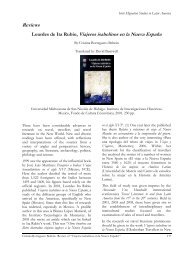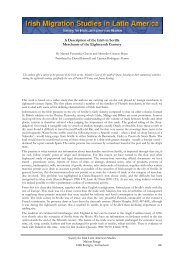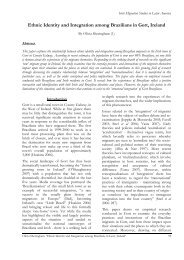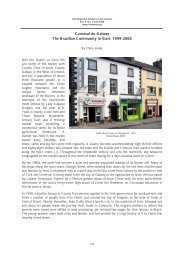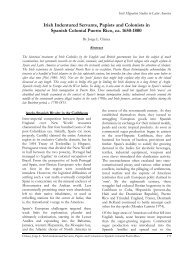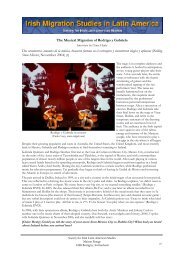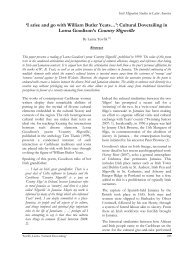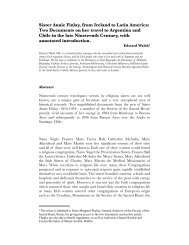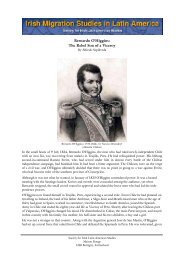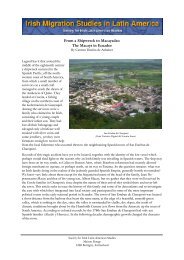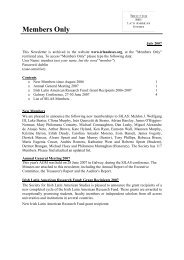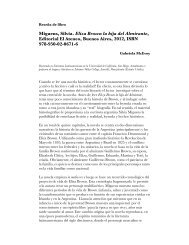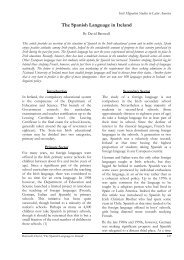I:6 Anti-dumping - Society for Irish Latin American Studies
I:6 Anti-dumping - Society for Irish Latin American Studies
I:6 Anti-dumping - Society for Irish Latin American Studies
Create successful ePaper yourself
Turn your PDF publications into a flip-book with our unique Google optimized e-Paper software.
nexus that supported the traffic in immigration in order to disclose a few of the pertinent experiential<br />
features of the emigrant’s world.<br />
Edmundo Murray<br />
Acknowledgements<br />
The in<strong>for</strong>mation about transportation in the nineteenth-century <strong>Irish</strong> midlands was obtained from the<br />
above-mentioned bibliography as well as from private correspondence with local historians. Among them,<br />
Ruth Illingworth oriented my research with appropriate in<strong>for</strong>mation and references. Ruth is a local<br />
historian based in Mullingar, Co. Westmeath, Chair of the Mullingar Historical and Archaeological<br />
<strong>Society</strong>, and author of Mullingar, History and Timeline, and When the Train Came to Mullingar (Mullingar:<br />
Westmeath Examiner, 1998). Librarians Greta Connell and Michael Dempsey, from Mullingar’s Westmeath<br />
County Library and Wex<strong>for</strong>d Town Library respectively, were very helpful to find both bibliography<br />
and newspapers with relevant references. Special thanks to David Barnwell, Bernard Canavan, Mike<br />
Geraghty, Pat McKenna, and Derek Ellwood <strong>for</strong> their valued comments on the text. I am also grateful to<br />
the Rev. Jeremy Howat, author of South <strong>American</strong> Packets 1808-1880 (York: The Postal History <strong>Society</strong>,<br />
1984), <strong>for</strong> his learned guidance through the world of the early South <strong>American</strong> seaway. Additionally,<br />
Jeremy generously read the article and provided helpful comments.<br />
Notes<br />
[1] According to Sabato and Korol ‘between 10,500 and 11,500 <strong>Irish</strong> immigrants settled in Argentina in<br />
the nineteenth century’ [Sabato and Korol, 1981: 48]. Patrick McKenna, based on sources indicating the<br />
existence of significant segments not recorded by the other authors, argued that the numbers were significantly<br />
higher, 40-45,000 emigrants. He said that Sabato and Korol’s calculation ‘was based on the<br />
assumption that Coghlan (1982) captured 100% of the <strong>Irish</strong> emigrants in his work on the census of 1869<br />
and 1855. They analysed Coghlan’s figures using statistics to build in assumptions <strong>for</strong> mortality and outmigration<br />
and further in-migration up to 1895 to arrive at their figure. The fact that there is such a<br />
difference between their figures and mine (especially when I allow <strong>for</strong> the possibility that my figures may<br />
be low) gives some indication of the room which exists <strong>for</strong> argument about the numbers of <strong>Irish</strong> who<br />
emigrated to Argentina during the nineteenth century’ [McKenna, 1994: 210]. [2] Ballymore was once<br />
known as ‘the village with two ends and no middle’: all the houses in the middle disappeared after their<br />
owners emigrated to Argentina (<strong>Irish</strong> Parliamentary Debates – Official Report: Dáil Éireann - Volume<br />
433 - 08 July, 1993).<br />
[3] In 1848, a family called Cunningham from near Ballymore sailed to Argentina from Southampton<br />
[Illingworth 2002].<br />
[4] Nowadays, there is a restoration scheme in progress and the section Dublin-Abbeyshrule is again<br />
navigable by small boats.<br />
[5] Named after Charles Bianconi (the king of the <strong>Irish</strong> roads), who started the first <strong>Irish</strong> mail coach service<br />
in 1815, beginning from the Hearn’s hotel in Clonmel, Co. Tipperary, to Thurles and Limerick. By 1825,<br />
Bianconi had 585 route miles and two decades later he had trebled. In 1836, long cars with twenty<br />
passengers capacity were added to the service. He had rivals but, where they often competed with the canal<br />
boats, Bianconi tended to run connecting feeder services, a move which enabled him to outstay many<br />
other operators.<br />
[6] Under ‘Mulvihill, William’ there are two entries in Leahy 1996: 166 (County Long<strong>for</strong>d Survivors of the<br />
Great Famine: a Complete Index to Griffith’s Primary Valuation of Co. Long<strong>for</strong>d 1854), and one in Leahy<br />
1990: 151 (County Long<strong>for</strong>d and its People: an Index to the 1901 Census <strong>for</strong> County Long<strong>for</strong>d).<br />
[7] One of the extreme cases mentioned by Eduardo Coghlan was ‘Luke Doyle, from Mullingar […], who<br />
arrived in Buenos Aires after a five and a half month journey’ [Coghlan 1987: 279]. Even longer was the<br />
journey of Sarah Elliff (née Flynn). She arrived in Buenos Aires on December 1848, after a six-months<br />
journey. Her ship weighed anchor at Liverpool on 20 June 1848, with 600 passengers on board. Thirty<br />
died during the journey, and many others stayed in Rio de Janeiro (Coghlan 1987: 306).<br />
Edmundo Murray, The <strong>Irish</strong> Road to South America..................................................................... 41



